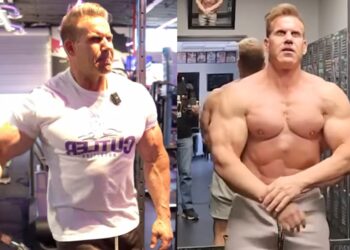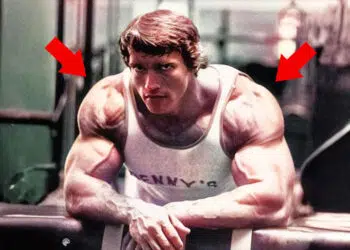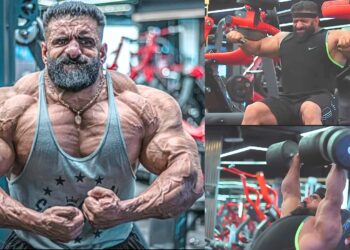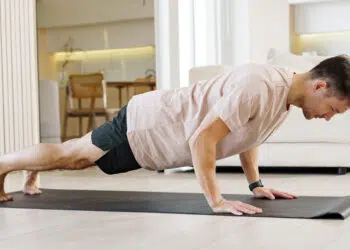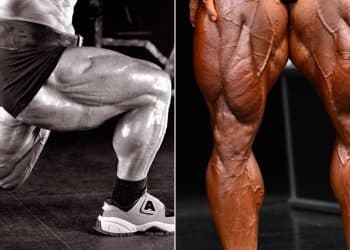Nothing will kill your gains like missing workouts. While you should do your very best to train consistently, it’s not always easy to get to the gym. Hitting the gym can also be time-consuming, especially if you face a long journey to get there.
The good news is that you can build an impressive physique without loads of workout gear, and you don’t even need to build a full home or garage gym.
Sculpt your deltoids and pump up your arms with our at-home shoulder and biceps workout. All you need is your body weight, some light dumbbells, and a resistance band.
Shoulder and Biceps Anatomy 101
While you don’t need a degree in anatomy and physiology to build impressive shoulders and biceps at home, knowing a little more about these muscle groups could help make your workouts more effective. If nothing else, you’ll be able to dazzle your family and friends with your newly acquired anatomical knowledge!
Shoulders
The correct name for the muscles of your shoulders is the deltoids. There are three sets of fibers that make up the deltoids, which are commonly referred to as heads. The deltoid heads work together to control your shoulder joint. Still, they can also be emphasized individually with certain exercises and movements.
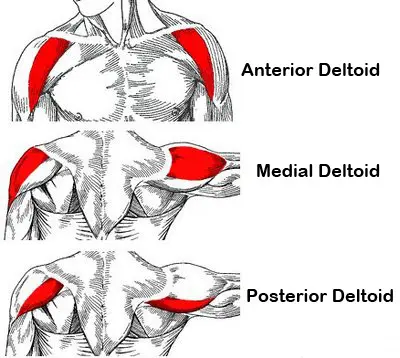
The three deltoid heads are:
Level Up Your Fitness: Join our 💪 strong community in Fitness Volt Newsletter. Get daily inspiration, expert-backed workouts, nutrition tips, the latest in strength sports, and the support you need to reach your goals. Subscribe for free!
Anterior deltoid – located on the front of your shoulders, the anterior deltoid flexes and medially rotates your upper arm. Exercises that emphasize this head include front raises and overhead presses.
Medial deltoids – the medial or middle deltoid is located on the side of your shoulder joint. Its function is to abduct your upper arm, meaning it raises your arm up and out to the side. The medial deltoid gives your shoulders their width. Exercises that target the medial deltoid include dumbbell and cable side raises.
Posterior deltoid – also known as the rear deltoid, this head is located on the back of your shoulder. It works in opposition to the anterior deltoid and is responsible for shoulder joint extension and external rotation. Exercises that target the posterior deltoid include reverse dumbbell flys and reverse cable crossovers.
Biceps
You probably already know more than enough about your biceps. After all, it’s the most famous muscle in the human body. Even non-lifters can usually identify their biceps and are happy to throw up an arm and flex for a biceps pose!
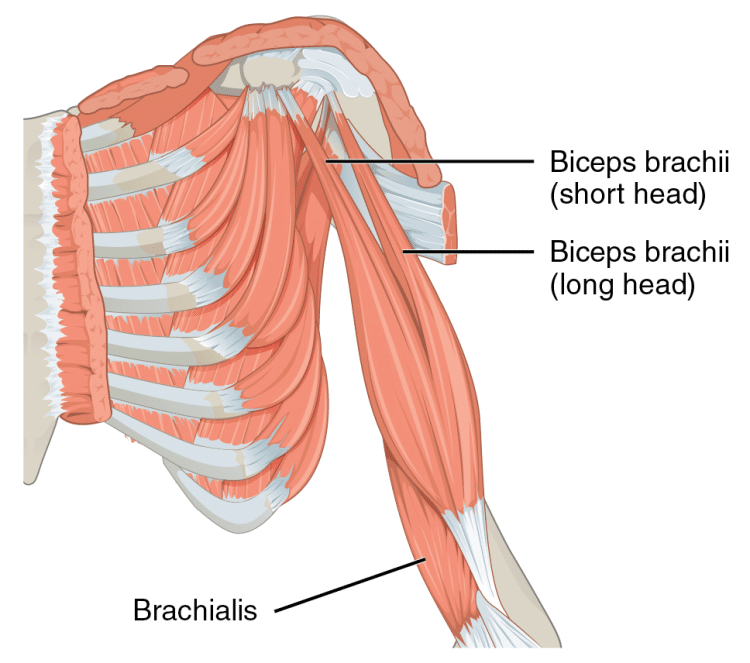
Still, we’ve told you all about the deltoids, so it’s only fair that the biceps get the same treatment…
Biceps brachii – the full name for the muscle on the front of your upper arm is biceps brachii, which means two-headed arm muscle. Known as the biceps for short, this muscle is responsible for flexion of the elbow, shoulder flexion, and supination of the forearm. The biceps have two heads (the long head and the short head) which refer to where they attach onto the shoulder joint.
Shoulder and Biceps Workout at Home – Overview
This home workout is designed to work all three deltoid heads and your biceps in an hour or less and with minimal exercise equipment.
In fact, all you need is your bodyweight, a pair of light dumbbells, and some resistance bands. If you don’t have dumbbells, you can use anything that doubles as hand weights, such as filled water bottles, cans of food, or bricks/rocks.
The workout itself is designed to be part of a split routine, where you train different muscles on different days. For example, you could train your chest and triceps one day, your legs the next, and then your shoulders and biceps after that. Make sure you train all of your major muscle groups at least once per week.
But, before you begin this or any workout, you need to prepare your muscles and joints for what you are about to do. Not only will this reduce your risk of injury, but it will also make your workout more productive.
So, to warm up, start with 5-10 minutes of easy cardio, such as jogging, jumping jacks, or jumping rope. Then, once you are warm and slightly out of breath, stretch and mobilize the muscles and joints you are about to use. Finally, take a moment to acquaint yourself with the exercises you are about to do, practicing any that you are unfamiliar with.
All warmed up and ready to go! Then let’s get to work!
Please note: Repetitions are listed for illustration purposes only. Depending on the weight of your dumbbells and the strength of your resistance bands, you may need to do more or fewer reps to fatigue your muscles. Just keep going until you are within a rep or two of failure. For the exercises designated AMRAP, just do As Many Reps As Possible.
| # | Exercise | Sets | Reps | Recovery |
| 1 | Pike push-up | 4 | AMRAP | 90 seconds |
| 2a | Dumbbell lateral raise (1 ½-reps) | 3 | 12-15 | 60 seconds |
| 2b | Band pull-apart | |||
| 4 | The ground is hot! | 2 | 40-60 seconds | 60 seconds |
| 5 | SEAL push-up challenge | 1 | 1, 2, 3, 4, 5, etc. | N/A |
| 6 | Jettison biceps curl | 3 | 8-10 | 60 seconds |
| 7 | Concentration curl | 4 | 15, 12, 10, 8 | N/A |
Exercises 2a and 2b are to be performed as a superset. Do a set of dumbbell lateral raises and then, without resting, immediately do a set of band pull-aparts. Rest for the prescribed time and then repeat the pairing for the specified number of supersets.
Exercise Descriptions
When it comes to getting the most from any exercise, you need to perform it correctly. Good exercise form keeps the tension on the target muscles. It minimizes momentum and unwanted joint stress for a safer, more effective workout.
And while using poor form may mean you can do more reps or lift a heavier weight, it doesn’t usually make your workout more productive and could even lead to injury.
Level Up Your Fitness: Join our 💪 strong community in Fitness Volt Newsletter. Get daily inspiration, expert-backed workouts, nutrition tips, the latest in strength sports, and the support you need to reach your goals. Subscribe for free!
So, given a choice, always train using good form – your muscles and joints will thank you!
1. Pike push-up
With no barbell or shoulder press machine, you may be wondering how you can build bigger, more muscular shoulders at home. This exercise is the solution. Pike push-ups closely resemble overhead presses and are a challenging bodyweight deltoid exercise.
How to do it:
- Squat down and place your hands on the floor about shoulder-width apart and fingers pointing forward. Walk your feet out and back into the push-up position. Brace your abs.
- Lift your butt up and back so that your body resembles an inverted V.
- Bend your arms and lower your head to the floor, keeping your hips up at all times.
- Push yourself back up until your arms are straight, and repeat.
- Make this exercise harder by raising your feet or placing your hands on blocks to increase your range of motion.
2a. Dumbbell lateral raise (1 ½-reps)
Dumbbell lateral raises target your medial or side deltoids. This is the deltoid head that gives your shoulders their width. Because of the long levers involved in this exercise, you probably won’t need to use heavy weights to get a good workout. However, to make it even more effective, you’ll be using something called the 1 ½-rep method to keep your deltoids under tension for longer.
How to do it:
- Hold a light dumbbell in each hand and stand with your arms by your sides. Brace your abs and pull your shoulders down and back. Bend your arms slightly but then keep them rigid.
- Raise your arms up and out to the side until they are parallel to the floor.
- Lower your arms halfway down to an angle of about 45 degrees.
- Raise your arms back up to parallel.
- Lower your arms all the way down to your sides.
- That’s one rep (or actually 1 ½ reps), so keep going!
- Move immediately to the next exercise to complete your superset
2b. Band pull-aparts
Band pull-aparts work the often-underdeveloped posterior or rear deltoid. In addition, this exercise also trains your middle trapezius and rhomboids, making it an excellent postural exercise. Combined with side later raises, this superset pairing will leave your shoulders pumped and burning.
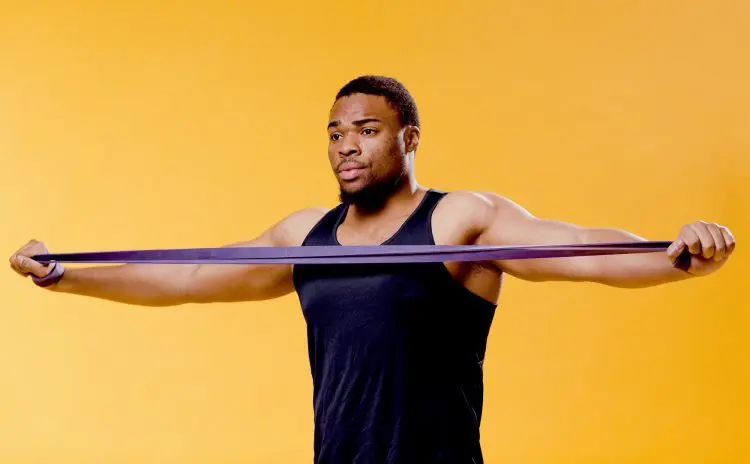
How to do it:
- Hold your resistance band with an overhand, slightly narrower than shoulder-width grip. Raise your arms in front of you, so your hands are level with your shoulders. Pull your shoulders down and back and brace your core.
- Without bending your elbows, open your arms and stretch the band out and across your chest.
- Return slowly to the starting position and repeat.
3. The floor is hot!
While you won’t need a lot of weight for this exercise, it will still provide your shoulders with a challenging (and painful!) workout. As well as working your deltoids, this exercise is good for improving shoulder mobility and stability.
How to do it:
- Hold a small weight plate in each hand and lie face down on the floor with your arms extended in front of you. Raise your arms a few inches off the floor.
- Keeping your arms raised, sweep your hands out, back, and down to your hips.
- Return to the starting position and repeat, taking care not to touch down at any time. Remember, the floor is hot!
- Continue for the prescribed duration.
- You can also do this exercise without weights.
4. SEAL push-up challenge
Push-ups are mostly thought of as a chest exercise, but they also work your shoulders. This SEAL push-up variation also involves a kneeling overhead press to really fry your deltoids.
The SEAL push-up challenge is an ascending rep ladder. You do one push-up, one kneeling overhead press, two push-ups, two kneeling overhead presses, and so on until you hit ten reps or reach failure. And yes, that burning in your shoulders is entirely normal!
How to do it:
- Adopt the push-up position with your arms and body straight, and core braced.
- Do one push-up.
- Kneel upright and do one no-weight shoulder press.
- Return to the push-up position and do two reps.
- Next, do two no-weight shoulder presses.
- Continue adding one rep per set until you reach ten reps or cannot continue.
- Check out the video for a full demonstration.
5. Jettison biceps curl
Jettison biceps curls are a form of drop set training. With this method, you combine freeweight and resistance band curls and, on reaching failure, release (jettison) the band and pump out a few more reps to fully fatigue your biceps. It’s a killer! While this method is usually used with barbell curls, as per the video, it works equally well with dumbbells.
How to do it:
- Hold a dumbbell in each hand and then stand on the center of a resistance band. Bend down and hold one end of the band in each hand as well as gripping your dumbbells. Then, stand up straight, brace your core, and pull your shoulders down and back.
- Bend your arms, curl the dumbbells up to your shoulder, lower them under control, and repeat to failure.
- Release the bands and then crank out a few more reps. Again, continue to failure.
- Rest a moment and repeat the entire sequence twice more for three sets.
6. Concentration curl
Concentration curls are often viewed as a shaping exercise. Still, they can actually be a great mass builder, too, especially when you do them after a more challenging exercise like jettison curls. For this exercise, you are going to perform your reps as a descending rep pyramid with no rest between arms. This will leave your biceps pumped and burning despite using light dumbbells.
How to do it:
- Sit on an exercise bench with a dumbbell in one hand. Lean forward, rest your triceps against your inner thigh, and let your arm hang down.
- Bend your elbow and curl the weight up to your shoulder. Extend your arm and repeat until you have completed the required number of reps.
- Switch arms and immediately do the same number of reps on the other side.
- Without resting, return to your first arm and pump out another set, doing a couple less reps because of fatigue.
- Again, swap arms and repeat.
- Continue going back and forth until you are down to around 50% of the number of reps you did at the start. This typically takes 3-5 sets.
More related workouts:
- Big Delts Fast: 30-Minute Shoulder Workout
- Chest and Shoulder Workout For Upper Body Size and Strength
- Kai Greene BOULDER Shoulders Workout
- Top 15 Biceps Peak Exercises For Building Monster Arms
- 9 Best Cable Exercises for Bigger Biceps
- 7 Best Back and Biceps Workouts for Strength and Mass
Wrapping Up
While it’s nice to have access to a well-equipped gym, you don’t need a ton of fancy training gear to have a great workout. Instead, bodyweight exercises, a light set of dumbbells, and some resistance bands are really all you need.
So, whether the gym is shut, you are stuck at home minding the kids, or you simply prefer to train at home, use this workout to sculpt your shoulders and build your biceps.
And remember, your muscles can’t distinguish between doing shoulder presses on a state-of-the-art machine and pike push-ups. They just know tension and work. Providing you train hard and consistently, your muscles will grow and get stronger wherever and however you work out.



